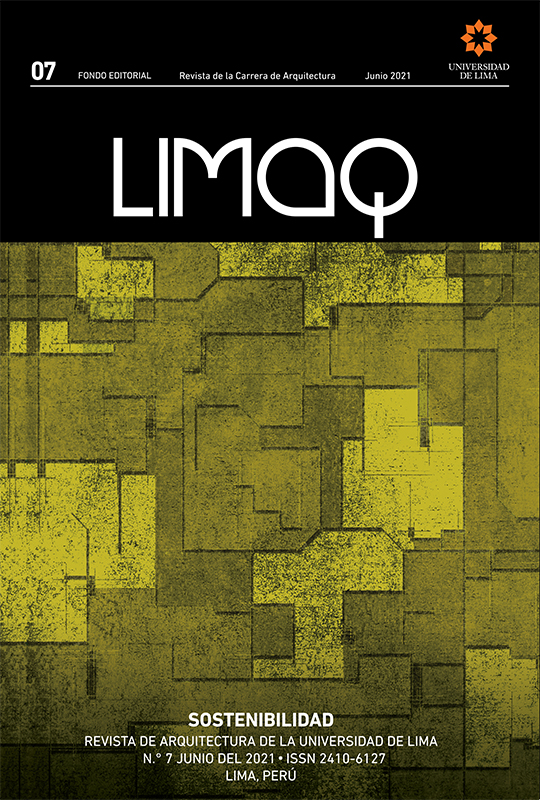Towards sustainability from architecture and ecosophy: links between mental ecology, emotional neuroscience and space
Keywords:
ecosophy, mental ecology, bioarchitecture, behavioral economics, neuroscience, transdisciplinary, ethics of architecture,, sustainabilityAbstract
DOI: https://doi.org/10.26439/limaq2021.n007.5177
This article arises from the review of books and research related to sustainability in terms of architecture, philosophy, psychology and neuroscience. It deals with the ecological problem from Felix Guattari’s ecosophical approach (environmental, social and mental ecology) and proposes transdisciplinary paths for its fulfillment. It also presents the relationship between mental ecology and the existential, artistic and ethical dimension of architecture based on emotional neuroscience. Finally, it raises design sensitization through the transdisciplinary knowledge of human beings in order to achieve a sensitive ideation in architectural proposals.
Downloads
References
Aggleton, J. P., y Mishkin, M. (1986). The Amygdala: Sensory Gateway to the Emotions. En R. Plutchik y H. Kellerman (Eds.), Emotion: Theory, Research and Experience, vol. 3: Biological Foundations of Emotion. Orlando: Academic Press.
Bachelard, G. (1957). La poétique de l’espace. París: Presses Universitaires de France.
Balmer, A. S., y Martin, P. (2008). Synthetic biology: Social and ethical challenges. Nottingham: Institute for Science and Society University of Nottingham.
Barrett, P., Davies, F., Zhang, Y., y Barrett, L. (2017). The Holistic Impact of Classroom Spaces on Learning in specific subjects. Environment and Behavior, 49(4), 425-451. doi: 10.1177/0013916516648735
Biran, A., Schmidt, W. P., Varadharajan, K. S., Rajaraman, D., Kumar, R., Greenland, K., Gopalan, B., Aunger, R., y Curtis, V. (2014). Effect of a Behavior-Change Intervention on Handwashing with Soap in India (SuperAmma): A Cluster-Randomised Trial. The Lancet Global Health, 2(3), e145-e154.
Cahill, L., Babinsky R., Markowitsch, H. J., y McGaugh, J. L. (1995). Amygdala and Emotional Memory. Nature, 377, 295-296.
Damasio, A. R. (2014). El error de Descartes: La emoción, la razón y el cerebro humano. Barcelona: Editorial Planeta.
Diéguez, A. (2013). Biología sintética, transhumanismo y ciencia bien ordenada. Viento Sur, (131), 71-80.
Farinella, M., y Roš, H. (2013). Neurocomic. Londres: Nobrow Press.
Foucault, M. (2009). Vigilar y castigar: nacimiento de la prisión. Buenos Aires: Siglo Veintiuno Editores (año de publicación del libro original, 1975).
Guattari, F. (1996). Las tres ecologías. Valencia: Pre-Textos.
Guenther, K. (2016). Between Clinic and Experiment: Wilder Penfield’s Stimulation Reports and the Search for Mind, 1929-55. Canadian Bulletin of Medical History, 33(2), 281-320. doi: 10.3138/cbmh.33.2.148-27012015
Haushofer, J., John, A., y Orkin, K. (2019). Can Simple Psychological Interventions Increase Preventive Health Investment? National Bureau of Economic Research, (NBER), (Working Paper n.° 25731).
Haushofer, J., y Metcalf, J. C. E. (2020). Combining Behavioral Economics and Infectious Disease Epidemiology to Mitigate the COVID-19 Outbreak. New Jersey: Princeton University.
Haverinen-Shaughnessy, U., y Shaughnessy, R. J. (2015). Effects of Classroom Ventilation Rate and Temperature on Students’ Test Scores. PloS ONE, 10(8), e0136165.
Herz, R. S., y Schooler, J. W. (2002). A Naturalistic Study of Autobiographical Memories Evoked by Olfactory and Visual Cues: Testing the Proustian Hypothesis. American Journal of Psychology, 115(1), 21-32.
Hursh, S. R. (1984). Behavioral Economics. Journal of the Experimental Analysis of Behavior, 42(3), 435-452.
Hussam, R., Rabbani, A., Reggiani, G., y Rigol, N. (2017). Rational Habit Formation: Experimental Evidence from Handwashing in India. Harvard Business School, Working Paper 18-030.
Karing, A. (2018). Social Signaling and Childhood Immunization: A Field Experiment in Sierra Leone. Berkeley: University of California.
Küller, R., Mikellides, B., y Janssens, J. (2009). Color, Arousal, and Performance-A Comparison of Three Experiments. Color Research & Application, 34(2), 141-152.
Lehrer, J. (2010). Proust y la neurociencia: Una visión única de ocho artistas fundamentales en la modernidad. Barcelona: Ediciones Paidós.
Mallgrave, H. F. (2011). The Architect’s Brain: Neuroscience, Creativity, and Architecture. New Jersey: John Wiley & Sons.
Mehta, R. K., Shortz, A. E., y Benden, M. E. (2015). Standing Up for Learning: A Pilot Investigation on the Neurocognitive Benefits of Stand-Biased School Desks. International Journal of Environmental Research and Public Health, 13(1), 59. doi:10.3390/ijerph13010059
Mogas-Soldevila, L., Duro-Royo, J., y Oxman, N. (2014). Water-Based Robotic Fabrication: Large-Scale Additive Manufacturing of Functionally Graded Hydrogel Composites via Multichamber Extrusion. 3D Printing and Additive Manufacturing, 1(3), 141-151.
Mullainathan, S., y Thaler, R. H. (2000). Behavioral Economics. National Bureau of Economic Research, (NBER), (Working Paper n.° 7948).
Norberg-Schulz, C. (1975). Existencia, espacio y arquitectura. Barcelona: Blume.
Oxman, N. (2011). Variable Property Rapid Prototyping: Inspired by Nature, Where Form Is Characterized by Heterogeneous Compositions, the Paper Presents a Novel Approach to Layered Manufacturing Entitled Variable Property Rapid Prototyping. Virtual and physical prototyping, 6(1), 3-31. doi: 10.1080/17452759.2011.558588
Oxman, N. (2015). Templating Design for Biology and Biology for Design. Architectural Design, 85(5), 100-107.
Pallasmaa, J. (2014). La imagen corpórea. Barcelona: Editorial Gustavo Gili.
Pallasmaa, J. (2016). Habitar. Barcelona: Editorial Gustavo Gili.
Penfield, W., y Rasmussen, T. (1950). The Cerebral Cortex of Man: A Clinical Study of Localization of Function. New York: Macmillan.
Pringle, H. (2013). The Origins of Creativity. Scientific American, 308(3), 36-43.
Steidle, A., y Werth, L. (2013). Freedom From Constraints: Darkness and Dim Illumination Promote Creativity. Journal of Environmental Psychology, 35, 67-80.
Wadley, L., Sievers, C., Bamford, M., Goldberg, P., Berna, F., y Miller, C. (2011). Middle Stone Age Bedding Construction and Settlement Patterns at Sibudu, South Africa. Science, 334(6061), 1388-1391.
Wargocki, P., y Wyon, D. P. (2007). The Effects of Moderately Raised Classroom Temperatures and Classroom Ventilation Rate on the Performance of Schoolwork by Children (RP-1257). HVAC&R Research, 13(2), 193-220. doi: 10.1080/10789669.2007.10390951
Watson, J., Dreibelbis, R., Aunger, R., Deola, C., King, K., Long, S., Chase R. P. y Cumming, O. (2019). Child’s Play: Harnessing Play and Curiosity Motives to Improve Child Handwashing in a Humanitarian Setting. International Journal of Hygiene and Environmental Health, 222(2), 177-182.
Weinthal, L. (Ed.). (2011). Toward a New Interior: An Anthology of Interior Design Theory. New York: Princeton Architectural Press.



